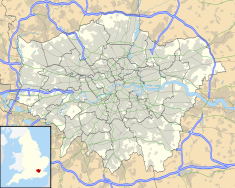Westminster Abbey
| Westminster Abbey | |
|---|---|
 The Abbey's western façade | |
| Location | Westminster, London, England |
| Coordinates | 51°29′58″N 00°07′39″W / 51.49944°N 0.12750°W |
| Built | 10th century[1] |
| Architectural style(s) | Gothic |
| Official name: Westminster Palace, Westminster Abbey and Saint Margaret's Church | |
| Type | Cultural |
| Criteria | i, ii, iv |
| Designated | 1987 (11th session) |
| Reference no. | 426 |
| Country | United Kingdom |
| Region | Europe and North America |
Listed Building – Grade I | |
| Official name: Westminster Abbey (The Collegiate Church of St Peter) | |
| Designated | 24 Feb 1958 |
| Reference no. | 1291494[2] |

Westminster Abbey is a large and famous Anglican church in Westminster, London. It is the shrine of Edward the Confessor and the burial place of many kings and queens. Since it was built it has been the place where the coronations of Kings and Queens of England have been held. The present structure dates from 1245, when it was started by Henry III.
The status of the Abbey is that of a Royal Peculiar. This means it is place of worship that falls directly under the jurisdiction of the British monarch, rather than under a bishop. The concept dates from Anglo-Saxon times, when a church could ally itself with the monarch and therefore not be subject to the bishop of the area. Technically speaking, it is not a cathedral, though it is regarded as one in practice.
One of the most famous tombs at Westminster Abbey is that of the Unknown Warrior.
Westminster Abbey and its small parish church, St Margaret's, form a UNESCO World Heritage site, which also includes Westminster Palace.[3]
Coronations[change | change source]
Since the coronations in 1066 of both King Harold and William the Conqueror, coronations of English and British monarchs were held in the Abbey.[4] Henry III was unable to be crowned in London when he first came to the throne because the French prince Louis (later Louis VIII) had taken control of the city. So the king was crowned in Gloucester Cathedral, but this coronation was deemed by the Pope to be improper, and a further coronation was held in the Abbey on 17 May 1220.[5] The Archbishop of Canterbury is the cleric in the coronation ceremony.
King Edward's Chair (or St Edward's Chair), is the throne on which British sovereigns sit when the crown is put on their heads. It is kept in the Abbey, and has been used at every coronation since 1308. From 1301 to 1996 (except for 1950 when it was briefly stolen by Scottish nationalists), the chair also housed the Stone of Scone upon which the kings of Scotland are crowned. Although the Stone is now kept in Scotland, at future coronations the Stone will be returned briefy to St Edward's Chair for the moment of coronation.
Centre of learning[change | change source]
Until the 19th century, Westminster was the third seat of learning in Oxford and Cambridge. It was here that the first third of the King James Bible Old Testament and the last half of the New Testament were translated. The New English Bible was also put together here in the 20th century.
Noteworthy[change | change source]

- The Abbey contains the Westminster Retable, the oldest known panel painting altarpiece in England.[6] It was painted in the 1270s by some of the Plantagenet court painters, probably for the High Altar. It was probably donated by Henry III of England as part of his Gothic redesign of the Abbey.[7] The painting survived only because it was incorporated into furniture between the 16th and 19th century and much of it has been damaged beyond restoration. According to one specialist the "Westminster Retable, for all its wounded condition, is the finest panel painting of its time in Western Europe".[8]
- The Abbey contains "the oldest door in Britain".[9]
Related pages[change | change source]
References[change | change source]
- ↑ Newcomb, Rexford (1997). "Abbey". In Johnston, Bernard (ed.). Collier's Encyclopedia. Vol. I A to Ameland (First ed.). New York, NY: P.F. Collier. pp. 8–11.
- ↑ "The National Heritage List For England". English Heritage. Archived from the original on 2012-05-01. Retrieved 2011-07-31.
- ↑ UNESCO, "Westminster Palace, Westminster Abbey and Saint Margaret's Church"; retrieved 2012-4-19.
- ↑ "Coronations". Dean and Chapter of Westminster Abbey. Archived from the original on 28 March 2009. Retrieved 19 April 2008.http://www.westminster-abbey.org/our-history/royals/coronations Archived 2009-03-28 at the Wayback Machine
- ↑ "Henry III, Archonotology.org". Retrieved 21 April 2008.
- ↑ Hamilton Kerr Institute Archived 2011-05-05 at the Wayback Machine, with full image of the retable, accessed July 13, 2010
- ↑ "Westminster Retable: England's Oldest Altarpiece" Archived 2009-05-07 at the Wayback Machine, National Gallery Exhibition Description, and accompanying press release Archived 2008-06-16 at the Wayback Machine. Retrieved December 24, 2008.
- ↑ Tudor-Craig, 105
- ↑ Notice attached to door in the Abbey.
Other websites[change | change source]
- Satellite view of Westminster Abbey at WikiMapia
- Westminster Abbey
- Keith Short - Sculptor Images of stone carving for Westminster Abbey
- A history of the choristers and choir school of Westminster Abbbey Archived 2006-06-23 at the Wayback Machine
- Adrian Fletcher’s Paradoxplace Westminster Abbey Pages — Photos Archived 2013-08-12 at the Wayback Machine


